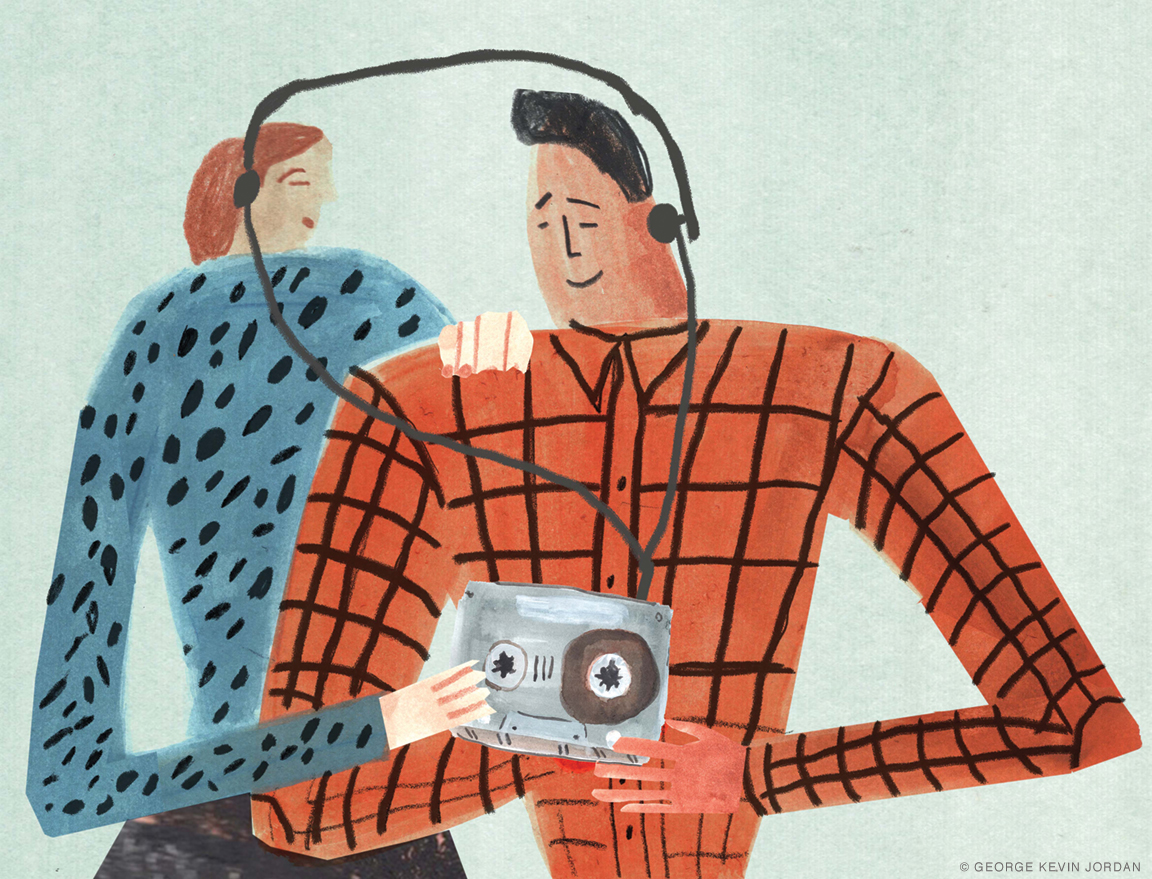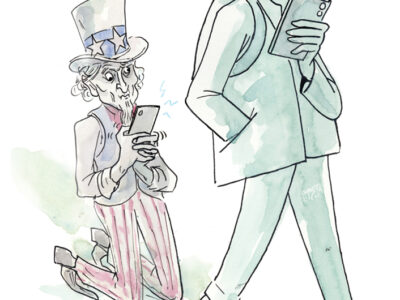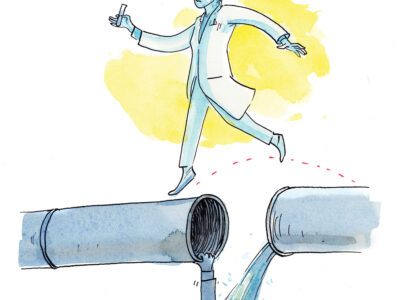
On the unlikely revival of cassette tapes.
By Rob Drew
In the late 2000s, a spate of stories appeared in major news outlets offering tips for music collectors who couldn’t bear the thought of their old cassettes being dumped in landfills or incinerated into toxic smoke. Cassettes presented a challenge for recyclers due to their varied and intricately connected parts. Public recycling centers lacked the infrastructure to process them, so readers would either have to pay specialist firms to take them apart or do so themselves. Their polystyrene shells might be ground down to plastic mulch or remolded into coat hangers. J-cards could be pulped along with other paper waste, and screws and springs reused for scrap metal. The polyester tape itself was nonrecyclable and all too plentiful; at the format’s height the music industry produced cassettes housing 150 million kilometers of tape each year, enough to stretch from the earth to the sun, much of which was now decomposing in attics and basements across the land. Readers were advised to be creative: tape could be used as twine to bundle newspapers or ribbon to wrap gifts. Gardeners could stretch it between posts over their vegetable plots, as the whistling wind and reflecting sunlight would scare away birds. If all else failed, parents could abandon their old cassettes to their toddlers, who, with proper oversight, might finally be permitted to indulge their instinct for extracting the insides from their elders’ favorite mix tapes.
The tutorials on repurposing old cassettes fairly captured the format’s status in 2009, with US cassette sales dwindling to a paltry 34,000 units. Yet in the following years, the feelings that music fans still attached to the cassette began coalescing into dreams of a revival. Efforts to recuperate the cassette were spearheaded by noise musicians, who never lost faith in it as an appropriately hissy, insistently physical medium to house their occult sounds. Soon new cassette labels were emerging from coastal cities and college towns, while established music labels began tentatively restoring tapes to their repertoires. Music news sites tracked the upward slope of cassette revenues with breathless headlines: “Cassette Sales Grew by 74% in 2016,” “Cassette Sales Rose 35% in 2017,” “U.S. Cassette Album Sales Grew 23% in 2018,” and finally, from the New Musical Express, “Who the Hell Is Buying Cassettes in 2020?”
Having bottomed out at such a miniscule base, percentage increases in sales overstate the cassette’s comeback, which still only accounts for a sliver of official music sales. Yet such figures overlook the countless labels that operate outside traditional distribution channels. Most labels are one- or two-person operations that design and dub tapes at home or through local shops, promote them through obsessive bloggers and podcasters, and sell them at merch counters and online marketplaces. One website for cassette fans keeps a running list of tape labels with over 500 entries, yet labels are constantly going in and out of business, and this is to say nothing of the many musicians who self-release cassettes and forgo labels altogether.
When promoters and fans are called upon to explain their continued attachment to the clunky cassette, their first response is usually that it’s cheaper than vinyl. Most vinyl record plants have a minimum order of 500 units and charge at least five dollars per unit for pressing and packaging; cassette duplicators will accept orders as small as 50 tapes, each of which can be dubbed, carded, boxed, and shrink-wrapped for under three dollars. Yet financial stakes fail to explain the emotional investment that the cassette garners among its devotees, who embrace the format as a symbol of creative plenitude that endows music exchange with a renewed sense of trustworthiness and selflessness. Most label owners claim a simple motivation: bringing artists to light whom they relate to as friends and genuine fans. The cassette release is understood less as a bundle of rights than a mutual gift that musicians and label owners feel privileged to collaborate on. Cassettes thus offer bands a relatively unmediated and minimally commercial way to connect with fans, one that harkens back to that vibrant, mail-based economy of cassette music that existed prior to the internet.
That faith in the cassette’s capacity to summon organic interactions around music extends to the listener, as the format is said to foster a more mindful and humane mode of listening, offering a refuge from the glut of online music. Even so, some find it hard to shake the suspicion that the cassette functions as little more than a fancy container for the download coupons many of them now contain—an agreeably chunky memento that will fit in fans’ pockets while only setting them back a few dollars. A 2014 UK market research survey found that about a quarter of cassette purchasers had no intention of listening to them. Even when only purchased as a souvenir, though, the cassette’s popularity heartens musicians and labels starved for paying customers—especially among the young, who not long ago had a reputation for declining to pay for music in any form.
Those proponents of cassettes who actually listen to them increasingly do so, not despite their much-maligned sound, but because of it. No longer dismissed as a muddy, mid-frequency alternative to vinyl, the cassette is hailed as an instrument whose audible quirks call for their own ways of listening. For some fans, the cassette’s intrinsic distortions (muffling of worn or dirty tape heads, wobbly textures of nth-generation copies, harmonic inconsistencies caused by speed fluctuations of cheap players) work as serendipitous embellishments to certain drony or psychedelic subgenres. For others, the cassette’s aberrations function as a kind of scrim to evoke the haziness and fragility of memory. In contrast to the bloodless persistence of digital formats, the sound of tape degrades with each successive duplication and even with each replaying; treble frequencies roll off, alien sounds print through from one layer to the next, clouds of muffle and hiss accumulate, and sounds fall away entirely where the tape has stretched, creased, or cracked. Among its proponents, though, the cassette’s frailty only amplifies its humanness.
The growing allure of cassette acoustics coupled with the format’s meager distribution have fueled a market run on tapes from certain formative artists and labels. Once a symbol of promiscuous distribution, the cassette has become a product of limited editions and collectibles. Some older, access-driven punks dismiss the current vogue for cassettes as a precious and overhyped postscript for a technology that long ago forfeited its status as the democratic format par excellence. Cynics have suggested that limited-edition cassettes have become one of those things, along with crypto art and meme stocks, that mischief-makers invest in to test the limits of where value can be created.
Still, the cassette’s resurgence endures like a Walkman on auto-reverse. It remains the format of choice for leftfield experimentalists, who seem to hatch new tape labels daily, each more surreal than the last down to their very monikers. (The noise-centric Tabs Out Cassette Podcast once ran an online quiz entitled “Tape Label or Weed Strain,” as the names of so many of the former could be mistaken for the latter: Orange Milk, Magical Garage Taste, Dream Fader, Cloud Valley, Peasant Magik, etc.) Major indies like Sub Pop, Drag City, and Polyvinyl now routinely release many of their new albums on cassette, as do all the major labels, decking them out with all the limited-edition flair that fans have come to expect. The cassette now has its niche and will likely go on lending the gravitas of its boxy tangibility to artists ranging from visionaries who sell a few dozen tapes to pop stars who move tapes, if not in the millions, at least well into five figures. The best-selling cassette of 2021, at 20,000 copies, was Sour by Olivia Rodrigo, whose breakup songs with echoes of 1990s-era emo sounded as much at home on tape as anything.
Rob Drew Gr’94 is the author of Unspooled: How the Cassette Made Music Shareable (copyright Duke University Press, 2024), from which this essay is adapted with permission.




